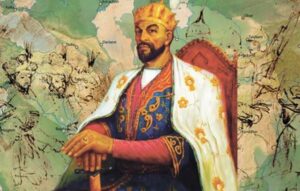SHARE WITH FRIENDS:
Among the greatest rulers and commanders in the history of the world are Alexander the Great, Gaius Julius Caesar, Napoleon Bonaparte, Alexander Suvorov, and the founder of the Timurid Empire, Timur. In Europe, he is known as Tamerlane, and the nickname “Timur-leng” translated from Persian means “lame Timur”. Timur got his second name for one reason: in 1362, in one of the battles, he was wounded in the leg and became lame.
Throughout his life, Tamerlan made many successful military campaigns against Mongolia, West Asia, Persia, India, the Ottoman Empire, and China. However, most importantly, the commander was remembered for his fight with the Golden Horde. From the first days of his reign, Tamerlane feared the state and tried to establish his political influence in the east. He marched three times against Genghis Khan's eldest son, the Golden Horde khan Tokhtamysh. The modern North Caucasus region has been affected by many military actions. The main event of the war against the Golden Horde took place here: in 1395, the battle of Terek ended with the defeat of the Horde. The battle largely predetermined the future fate of the Golden Horde, which had lost its previous power and influence.
Tamerlan began his first expeditions to the Caucasus in 1386 and 1394. With the war, he conquered the territories of present-day northern Iran, Azerbaijan, Armenia, and Georgia. The Georgian-mountain army managed to hold the strong commander for a while, but Tamerlan managed to defeat them. Georgians and Nakhs retreated to the north, to the valleys of the Greater Caucasus. Mountain roads and passes were strategically important to Tamerlane. He decided to continue his march in order to capture the castle in the river gorge. However, the huge armies in the gorge were ineffective and Tamerlan was forced to retreat.
In 1395, Tamerlane's army of 300 men marched against the Golden Horde. He gathered near Derbent, then passed through Dagestan, crushing the front detachments of the Stop. Tamerlan crossed the Sunja and Terek rivers and reached the modern Kabardino-Balkaria region. It was here, near the ancient city of Djulata, not far from the modern city of Maysky, that on April 1395, 15, the greatest battle of the fourteenth century took place, which lasted three days. It was attended by about half a million people. The Stopping Army was severely defeated and ordered the invader Tamerlan Djulat to be annihilated.
After the victory, Tamerlan Tokhtamysh and his allies set out to destroy the remnants of the army. In 1395, he destroyed the Circassian region, conquered the lands of the Western Alan rulers Buriberdi and Burakan, conquered the castles of Kuli and Taus in the mountains of North Ossetia and Bulgaria, and also conquered the province of Ikhran in the region. Ossetia and Ingushetia.
Tamerlan put a lot of effort into conquering the country of Simsim - the ancient Chechen state, the famous village of Gudermes, the town of Almak in Sulak and the Chechen plain. His march against Chechnya was so terrible that the memory of the events of those years was long preserved in the folklore, for example, in the legends and myths about "Aksak-Temur".
In early 1396, Tamerlan traveled north to conquer the Golden Horde cities along the Volga. Returning after successful battles, Tamerlan pitched a tent on the Golden Fortress mountain at his headquarters in the Stavropol Territory to rest. In the spring of that year, he continued to invade Dagestan again, where a united army of Avars, Lazgins, and other mountaineers was defeated. In the fall, Tamerlan left the North Caucasus via Derbent to invade Transcaucasia, Syria, and Asia Minor.
In battles with the Highlanders, Tamerlan was convinced that he could not defend the North Caucasus for himself. The borders of his state remained in line. At the same time, Tamerlane's march to the North Caucasus left an indelible mark: many large ancient cities and hundreds of villages were completely destroyed, seriously affecting the local population. The invasion eventually weakened the Golden Horde, which did not regain its power during the 15th century and was divided into separate khanates and estates.
